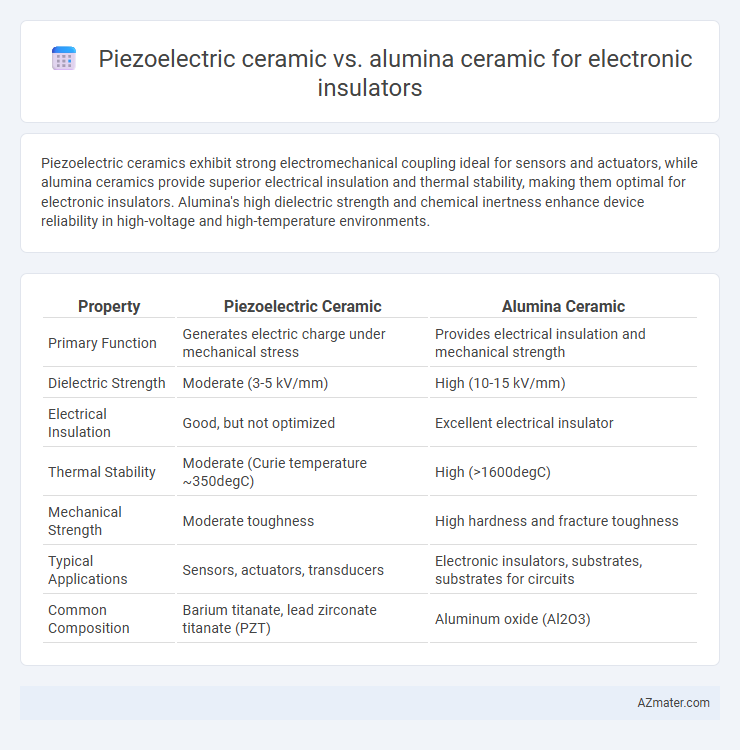Piezoelectric ceramics exhibit strong electromechanical coupling ideal for sensors and actuators, while alumina ceramics provide superior electrical insulation and thermal stability, making them optimal for electronic insulators. Alumina's high dielectric strength and chemical inertness enhance device reliability in high-voltage and high-temperature environments.
Table of Comparison
| Property | Piezoelectric Ceramic | Alumina Ceramic |
|---|---|---|
| Primary Function | Generates electric charge under mechanical stress | Provides electrical insulation and mechanical strength |
| Dielectric Strength | Moderate (3-5 kV/mm) | High (10-15 kV/mm) |
| Electrical Insulation | Good, but not optimized | Excellent electrical insulator |
| Thermal Stability | Moderate (Curie temperature ~350degC) | High (>1600degC) |
| Mechanical Strength | Moderate toughness | High hardness and fracture toughness |
| Typical Applications | Sensors, actuators, transducers | Electronic insulators, substrates, substrates for circuits |
| Common Composition | Barium titanate, lead zirconate titanate (PZT) | Aluminum oxide (Al2O3) |
Introduction to Electronic Insulator Materials
Piezoelectric ceramic offers high dielectric strength and electromechanical coupling, making it ideal for sensors and actuators in electronic insulation. Alumina ceramic provides excellent thermal stability, mechanical strength, and electrical insulation, widely used in harsh environments requiring reliable dielectric performance. The choice between piezoelectric and alumina ceramics depends on specific application needs, balancing factors like dielectric constant, thermal conductivity, and mechanical durability.
Overview of Piezoelectric Ceramics
Piezoelectric ceramics, primarily composed of lead zirconate titanate (PZT), exhibit the unique ability to convert mechanical stress into electrical energy and vice versa, making them essential in sensors, actuators, and transducers. Compared to alumina ceramic, which is valued for its exceptional electrical insulation and thermal conductivity, piezoelectric ceramics provide both dielectric insulation and active electromechanical functionality. The intrinsic crystalline structure of piezoelectric ceramics enables precise control in electronic devices, whereas alumina primarily serves passive insulating roles.
Overview of Alumina Ceramics
Alumina ceramics exhibit exceptional electrical insulation properties, high mechanical strength, and excellent thermal stability, making them ideal for electronic insulator applications. Unlike piezoelectric ceramics, which generate electric charge under mechanical stress, alumina ceramics primarily serve as robust, non-conductive substrates in electronic devices. Their high dielectric strength and chemical inertness ensure reliable insulation and durability in harsh operating environments.
Key Properties of Piezoelectric Ceramics
Piezoelectric ceramics exhibit unique electromechanical coupling, enabling them to convert mechanical stress into electrical charge, which is crucial for sensors and actuators in electronic insulators. These ceramics possess high dielectric constants, excellent piezoelectric coefficients (d33 typically ranging from 100 to 700 pC/N), and strong mechanical strength, making them suitable for precise signal transduction. In contrast, alumina ceramics primarily serve as electrical insulators with superior thermal conductivity, high dielectric strength, and mechanical robustness but lack piezoelectric properties necessary for active sensing or energy harvesting applications.
Key Properties of Alumina Ceramics
Alumina ceramics exhibit exceptional electrical insulation, high dielectric strength, and outstanding thermal conductivity, making them ideal electronic insulators in high-voltage and high-frequency applications. Their excellent mechanical strength and chemical stability ensure durability and resistance to wear in harsh environments, outperforming piezoelectric ceramics in insulating performance. Unlike piezoelectric ceramics, alumina ceramics maintain consistent insulating properties without generating electric charge under mechanical stress.
Electrical Insulation Performance Comparison
Piezoelectric ceramics exhibit moderate electrical insulation properties with resistivity typically ranging from 10^9 to 10^12 ohm-cm, which is suitable for sensing and actuating applications but may limit their use in high-voltage insulation environments. Alumina ceramics offer superior electrical insulation performance, featuring resistivity values exceeding 10^14 ohm-cm and a dielectric strength above 10 kV/mm, making them ideal for high-voltage and high-temperature electronic insulator applications. The higher purity and crystal structure of alumina ceramic provide better dielectric stability and lower dielectric loss compared to piezoelectric ceramics, ensuring more reliable electrical isolation in demanding conditions.
Thermal Stability and Conductivity Analysis
Piezoelectric ceramics demonstrate moderate thermal stability with operational ranges typically between -40degC to 250degC, making them suitable for applications requiring dynamic electrical response under varied temperatures, whereas alumina ceramics exhibit superior thermal stability up to approximately 1600degC, ideal for high-temperature electronic insulation. In terms of electrical conductivity, piezoelectric ceramics maintain low conductivity essential for sensor functionality, but alumina ceramics offer exceptional electrical insulation due to their extremely high resistivity, often exceeding 10^14 ohm-cm. The thermal conductivity of alumina ceramics ranges between 20 to 30 W/m*K, significantly higher than the typically lower thermal conductivity of piezoelectric ceramics, impacting heat dissipation efficiency in electronic insulators.
Mechanical Strength and Durability
Piezoelectric ceramic exhibits high mechanical strength and durability due to its crystalline structure, making it effective for applications requiring vibration sensing and energy harvesting. Alumina ceramic offers superior hardness, wear resistance, and exceptional durability under high-temperature and harsh chemical environments, ensuring reliable long-term insulation performance. Comparing both, alumina ceramic is preferred for robust mechanical strength and prolonged durability in electronic insulator applications subjected to extreme conditions.
Applications in Electronic Devices
Piezoelectric ceramics excel in applications such as sensors, actuators, and ultrasonic transducers due to their ability to convert mechanical stress into electrical signals and vice versa. Alumina ceramics, known for their high dielectric strength, thermal stability, and excellent electrical insulation, are widely used as substrates, insulating layers, and protective components in electronic devices. The choice between piezoelectric and alumina ceramics depends on the need for electromechanical functionality versus robust electrical insulation in electronic systems.
Choosing the Right Ceramic for Electronic Insulators
Selecting between piezoelectric ceramic and alumina ceramic for electronic insulators depends on application requirements; alumina ceramic offers superior electrical insulation, thermal conductivity, and mechanical strength, making it ideal for high-voltage and high-temperature environments. Piezoelectric ceramics, while providing electromechanical coupling useful in sensors and actuators, generally have lower insulation resistance and are less suited for purely insulating purposes. Prioritizing alumina ceramic ensures reliable insulation performance in demanding electronic components and systems.

Infographic: Piezoelectric ceramic vs Alumina ceramic for Electronic insulator
 azmater.com
azmater.com